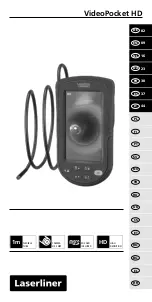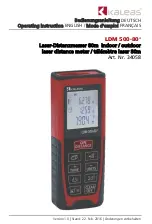
5
2.4 OBD II Readiness Monitors
1) Misfire
2) Fuel System
3) Comprehensive Components (CCM)
1) EGR System - exhaust Gas Recirculation for reducing greenhouse gases.
2) O2 Sensors - monitor and adjust air/fuel mixture.
3) Catalyst - reduces exhaust emissions.
4) Evaporative System - monitors the integrity of the fuel tank system
5) O2 Sensor Heater - brings O2 sensor to correct operating temperature
6) Secondary air - reduces exhaust emissions.
7) Heated Catalyst - brings catalyst to correct operating temperature.
8) 8)A/C system - monitors system for freon leaks.
Readiness Monitors are indicators used to find out if all of the emissions
components have been evaluated by the OBD II system. They are running periodic
tests on specific systems and components to ensure that they are performing
Currently, there are eleven OBD II Readiness Monitors (or l/M Monitors) defined
by the U.S. Environmental Protection Agency (EPA). Not all monitors are supported
by all vehicles and the exact number of monitors in any vehicle depends on the
Continuous Monitors – Some of the vehicle components or systems are
continuously tested by the vehicle’s OBD II system, while others are tested only
under specific vehicle operating conditions. The continuously monitored
Once the vehicle is running, the OBD II system is continuously checking the
above components, monitoring key engine sensors, watching for engine misfire,
Non-Continuous Monitors – Unlike the continuous monitors, many emissions
and engine system components require the vehicle to be operated under specific
conditions before the monitor is ready. These monitors are termed non-continuous
within allowable limits.
motor vehicle manufacturer’s emissions control strategy.
components listed below are always ready
and monitoring fuel demands.
monitors and are listed below:
6
2.5 OBD II Monitor Readiness Status
2.6 OBD II Definitions
OBD II systems must indicate whether or not the vehicle’s PCM’s monitoring
hascompleted testing on each emission component. Components that have been
OBD II tested will be reported as “OK”. The purpose of recording readiness status is
to allow inspectors to determine if the vehicle’s OBDII system has tested all the
emissions systems. This is handy to know before bringing vehicle to a state
In order for the OBD monitor system to become ready, the vehicle should be
driven under a variety of normal operating conditions. These operating conditions
may include a mix of highway driving and stop and go, city type driving, and at
least one overnight-off period. For specific information on getting your vehicle’s
Powertrain Control Module (PCM) – the OBD II terminology for the on-board
Malfunction Indicator Light (MIL) – Malfunction Indicator Light (Service Engine
Soon, Check Engine) is a term used for the light on the instrument panel. It is to
alert the driver and/or the repair technician that there is a problem with one or
more of vehicle’s systems and may cause emissions to exceed federal standards.
If the MIL illuminates with a steady light, it indicates that a problem has been
detected and the vehicle should be serviced as soon as possible. Under certain
conditions, the dashboard light will blink or flash. This indicates a severe problem
and flashing is intended to discourage vehicle operation. The vehicle onboard
diagnostic system can’t turn the MIL off until necessary repairs are completed or
The powertrain control module (PCM) sets a monitor to “OK” after an
appropriate drive cycle has been performed. The drive cycle that enables a Monitor
and sets readiness codes to “OK” varies for each individual monitor. Once a monitor
is set as “OK”, it will remain in this state. A number of factors, including erasing of
diagnostic trouble codes (DTCs) with a code reader or a disconnected battery, can
result in Readiness Monitors being set to “INC” (incomplete). Since the three
continuous monitors are constantly evaluating, they will be reported as “OK” all of
the time. As long as there are no DTCs stored in memory, the vehicle is running in
accordance with the OBD II guidelines. If testing of a particular support
non-continuous monitor has not been completed or not tested, the monitor status
emissions testing facility.
will be reported as “INC” (incomplete).
OBD monitor system ready, please consult your vehicle owner’s manual.
computer that controls the engine and the drivetrain.
the condition no longer exists.
7
DTC – Diagnostic Trouble Codes (DTC) these identify which section of
Enabling Criteria – Also termed Enabling Conditions. They are the vehicle-spe-
cific events of conditions that must occur within the engine before the various
monitors will set, or run. Some monitors require the vehicle to follow a prescribed
“drive cycle” routine as part of the enabling criteria. Drive cycles vary among
OBD II Drive Cycle – A specific mode of vehicle operation that provides
conditions required to set all the readiness monitors applicable to the vehicle to the
“ready” condition. The purpose of completing an OBD II drive cycle is to force the
vehicle to run its onboard diagnostics. Some form of a drive cycle needs to be
performed after DTCs have been erased from the PCM’s memory or after the battery
has been disconnected. Running through a vehicle’s complete drive cycle will “set”
the readiness monitors so that future faults can be detected. Drive cycles vary
depending on the vehicle and the monitor that needs to be reset. For vehicle
Freeze Frame Data – When an emissions related fault occurs, the OBD II system
not only sets a code, but also records a snapshot of the vehicle operating
parameters to help in identifying the problem. This set of values operating
parameters to help in identifying the problem. This set of values is referred to as
Freeze Frame Date and may include important engine is referred to as Freeze Frame
Date and may include important engine parameters such as engine RPM, vehicle
speed, air flow, engine load, fuel pressure, fuel trim value, engine coolant
the emission control system has malfunctioned.
vehicles and for each monitor in any particular vehicle.
specific drive cycle, consult the vehicle’s Owner’s Manual.
temperature, ignition timing advance, or closed loop status.
4
2.3 Location of the Data Link Connector (DLC)
Figure 2-1: Explanation of a diagnostic trouble code.
DTC Example
P 0 1 2 3
Systems
Code Type
Generic ( SAE):
P0
B0
C0
U0
Manufacturer Specific:
P1, P2
B1, B2
C1, C2
U1, U2
Sub- systems
1 = Fuel and air metering
2 = Ignition system or engine misfire
3 = Auxiliary emissions controls
4 = Vehicle speed control and idle controls
5 = Computer output circuits
6 = Transmission controls
Last two digits identify individual
component within the system
B = Body
C = Chassis
P = Powertrain
U = Network
The DLC (Data Link Connector or Diagnostic Link Connector) is the standardized
16-cavity connector where diagnostic scan tools interface with the vehicle's
on-board computer. The DLC is usually located 12 inches from the center of the
instrument panel (dash), under or around the driver's side for most vehicles. If the
Data Link Connector is not located under the dashboard, a label should be there
revealing its location. For some Asian and European vehicles, the DLC is located
behind the ashtray and the ashtray must be removed to access the connector. If the
DLC cannot be found, refer to the vehicle's service manual for the location.
Figure 2-2: The DLC connector (left) can be found in
the area of the car interior seen at right (black arrow).
NEAR CENTER
OF DASH
LEFT CORNER
OF DASH
BEHIND
ASHTRAY























